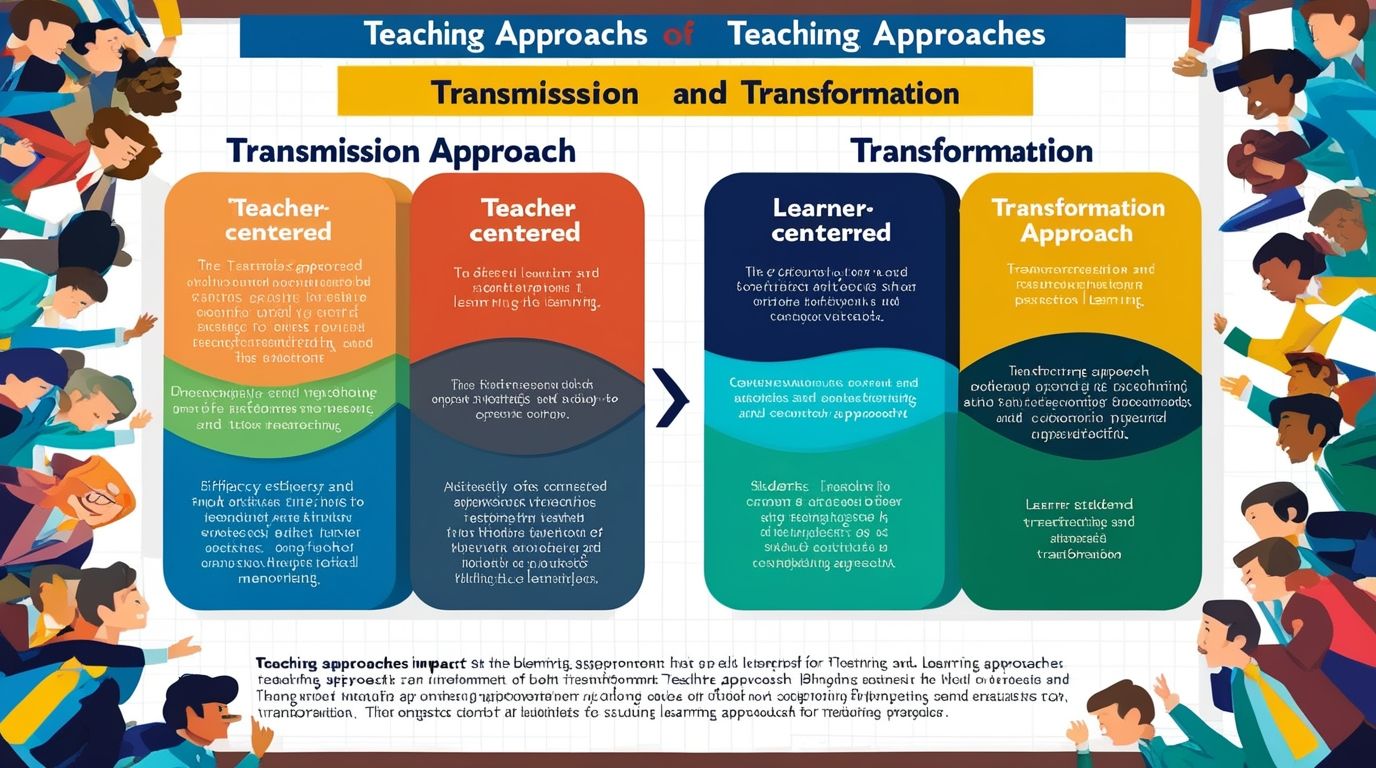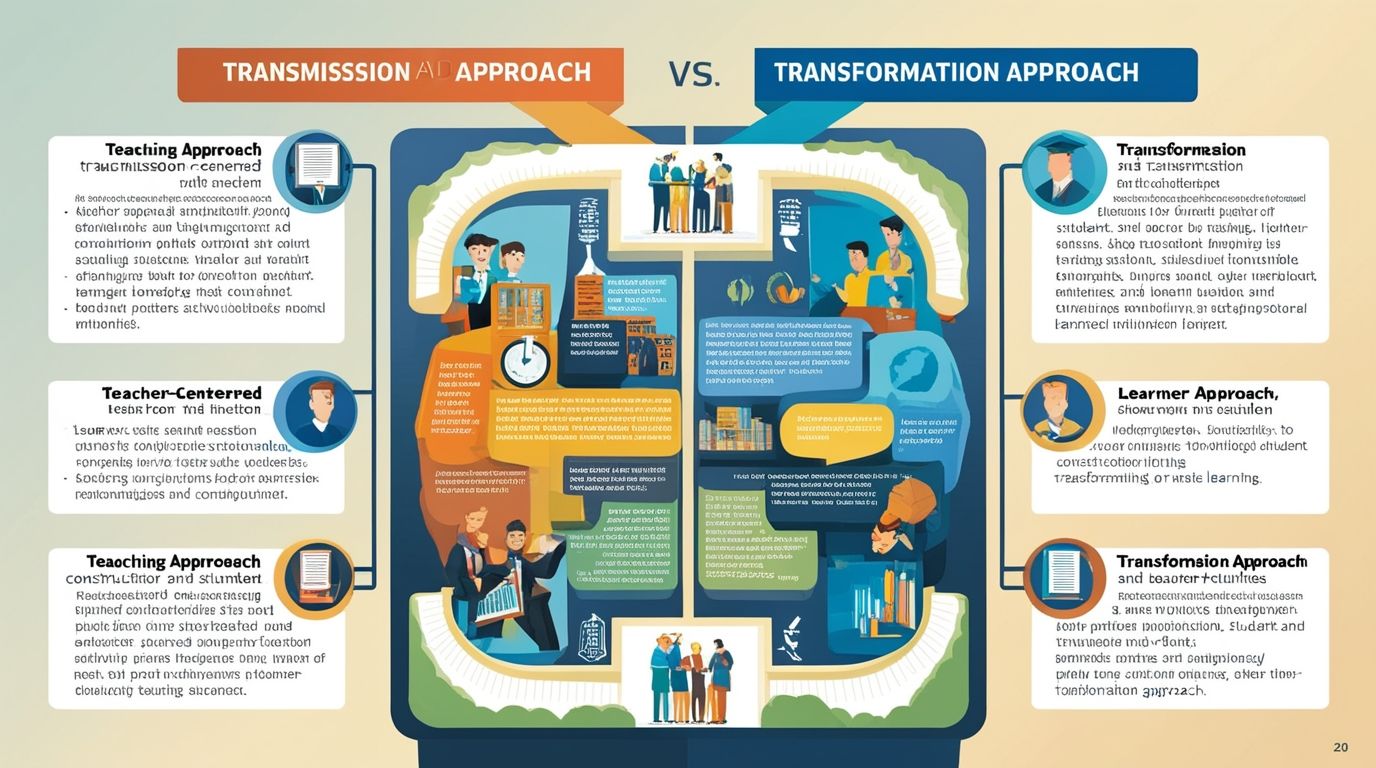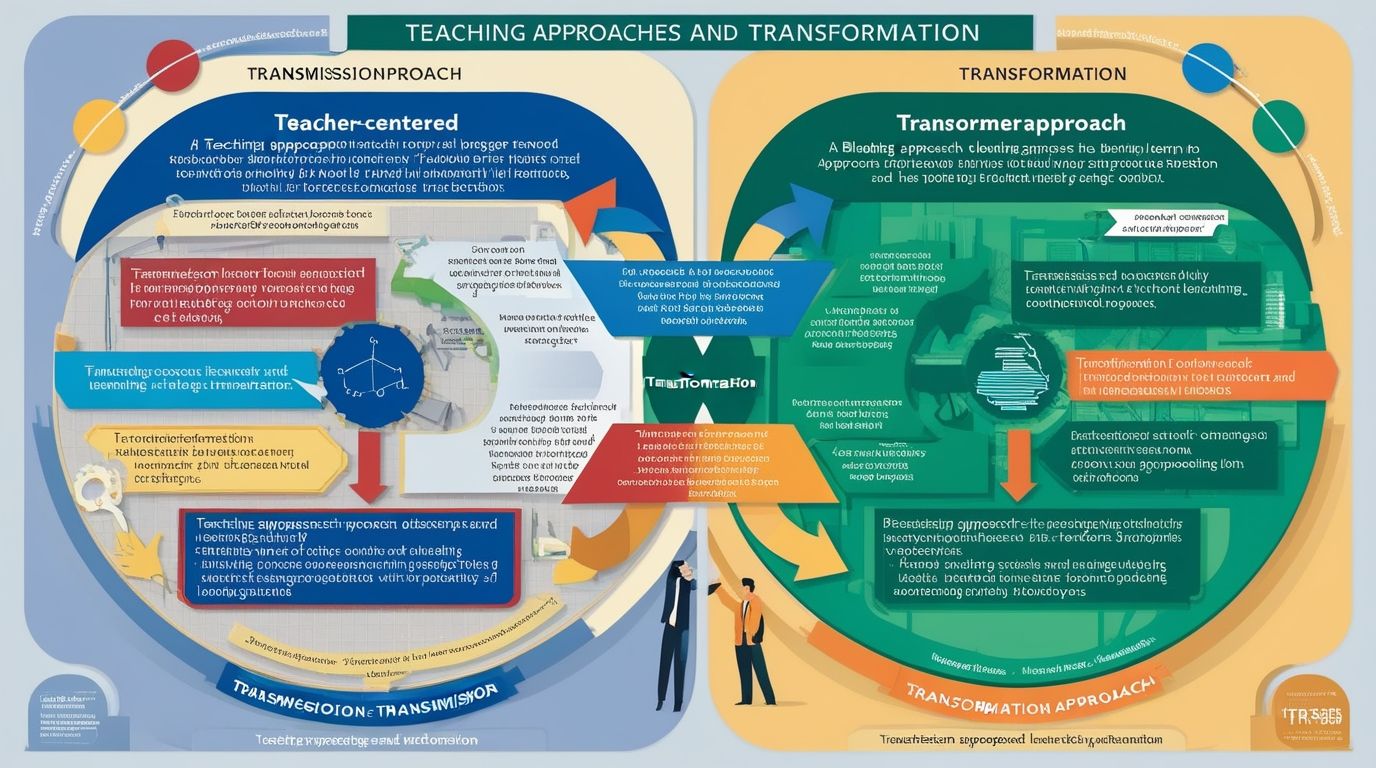Teaching Approaches: Transmission and Transformation, Teaching is a dynamic and multifaceted profession that involves various approaches to cater to the diverse needs of learners. Among these approaches, the transmission and transformation models stand out as two distinct methodologies with unique philosophies and practices. This article explores the essence, applications, and implications of these two teaching approaches.
Transmission Approach
The transmission approach, also known as the traditional or teacher-centered approach, is rooted in the belief that knowledge is a fixed entity that can be transferred from teacher to student. This method emphasizes the teacher’s role as the primary source of knowledge and authority in the classroom.
Characteristics of the Transmission Approach
- Teacher-Centered Instruction: The teacher is the central figure, directing all activities and maintaining control over the learning environment.
- Lecture-Based Delivery: Information is predominantly delivered through lectures, with students expected to passively receive and absorb the content.
- Emphasis on Memorization: Students are often required to memorize facts, concepts, and procedures, with a focus on rote learning.
- Standardized Assessments: Evaluation is usually through standardized tests that measure the recall of information.
- Fixed Curriculum: The curriculum is predefined and structured, with little room for deviation or exploration beyond the set content.

Advantages of the Transmission Approach
- Efficiency in Information Delivery: This approach can efficiently cover a large amount of content in a short period.
- Clarity and Structure: The structured nature provides clear guidelines and expectations for both teachers and students.
- Predictability in Outcomes: Standardized assessments can offer a clear measure of student achievement and progress.
Criticisms of the Transmission Approach
- Passive Learning: Students often become passive recipients of information, leading to a lack of engagement and critical thinking.
- Limited Adaptability: The rigid structure may not cater to diverse learning styles and needs.
- Surface Learning: The emphasis on memorization can result in superficial understanding rather than deep comprehension.
Transformation Approach
The transformation approach, also known as the learner-centered or constructivist approach, focuses on the belief that learning is an active, constructive process. It emphasizes the role of the learner in creating meaning and understanding through experiences and interactions.
Characteristics of the Transformation Approach
- Learner-Centered Instruction: Students are at the center of the learning process, with teachers acting as facilitators and guides.
- Active Learning: Emphasis on activities that promote critical thinking, problem-solving, and collaboration.
- Constructivist Pedagogy: Knowledge is constructed through experiences, discussions, and reflections.
- Flexible Curriculum: The curriculum is adaptable, allowing for exploration and inquiry based on students’ interests and needs.
- Formative Assessments: Continuous assessment through observations, discussions, and reflective practices to support learning.
Advantages of the Transformation Approach
- Engagement and Motivation: Active participation and relevance to personal experiences enhance student engagement and motivation.
- Critical Thinking and Problem-Solving: Encourages deeper understanding and the development of higher-order thinking skills.
- Adaptability: Can cater to diverse learning styles and needs, promoting inclusivity and equity.
- Lifelong Learning Skills: Fosters skills that are essential for lifelong learning and adaptability in a rapidly changing world.
Criticisms of the Transformation Approach
- Time-Consuming: Requires more time for planning and implementation, which can be challenging in tightly scheduled curricula.
- Assessment Challenges: Measuring outcomes can be more complex and less standardized.
- Resource Intensive: May require more resources, such as materials, training, and smaller class sizes.

Practical Applications and Blended Approaches
In practice, many educators find value in blending elements of both transmission and transformation approaches to create a balanced and effective learning environment.
Blended Learning
Blended learning integrates traditional teaching methods with modern, interactive techniques. This can involve:
- Flipped Classrooms: Where students engage with lecture material at home and participate in active learning during class time.
- Project-Based Learning: Combining structured content delivery with projects that require critical thinking and problem-solving.
- Technology Integration: Using digital tools to enhance both the delivery of information and the facilitation of interactive, student-centered activities.
Case Study: A Balanced Approach
Consider a high school science class where the teacher employs a balanced approach. The teacher starts with a brief lecture (transmission) to introduce key concepts and provide foundational knowledge. This is followed by a lab activity (transformation) where students design experiments, collect data, and draw conclusions. The teacher facilitates discussions, encourages inquiry, and provides guidance as students navigate the learning process.
Assessment in this scenario includes both traditional tests to evaluate the understanding of core concepts and formative assessments such as lab reports, presentations, and reflective journals to gauge deeper comprehension and application of knowledge.
Implications for Educators and Policymakers
Educators and policymakers must consider the advantages and limitations of both approaches to design effective curricula and teaching strategies. The choice of approach can significantly impact student engagement, learning outcomes, and overall educational experience.
Professional Development
Investing in professional development for teachers is crucial to equip them with the skills and knowledge to effectively blend transmission and transformation approaches. Workshops, training sessions, and collaborative planning can help teachers integrate diverse methodologies and adapt to the evolving educational landscape.
Curriculum Design
Curriculum design should be flexible enough to incorporate both structured content and opportunities for experiential learning. This requires a shift from rigid, standardized curricula to more dynamic, student-centered frameworks that promote inquiry, creativity, and critical thinking.
Policy Considerations
Policymakers should consider the implications of assessment policies and resource allocation. Supporting schools with adequate resources, smaller class sizes, and access to technology can facilitate the implementation of blended teaching approaches. Additionally, assessment policies should recognize the value of formative assessments and alternative measures of student success.
Conclusion
The transmission and transformation teaching approaches represent two ends of the educational spectrum, each with its strengths and challenges. While the transmission approach offers structure and efficiency, the transformation approach promotes engagement and critical thinking. A balanced, blended approach can harness the benefits of both, creating a dynamic and inclusive learning environment that prepares students for the complexities of the modern world. By embracing the strengths of each approach and adapting to the needs of diverse learners, educators can foster a rich and meaningful educational experience that cultivates lifelong learning and growth.

Your blog is a constant source of inspiration for me. Your passion for your subject matter is palpable, and it’s clear that you pour your heart and soul into every post. Keep up the incredible work!
Sultanbeyli su kaçağı tespiti Bakırköy su kaçağı tespiti: Bakırköy’de su kaçağı sorunlarını hızlıca çözmekteyiz. https://www.finlandmlbforum.com/ustaelektrikci
buy priligy Treatment of vulvar TB is with ATT rifampicin, isoniazide, pyrazinamide, and ethambutol for the first 2 months followed by rifampicin, isoniazide, and ethambutol for subsequent 4 months as per standard guidelines
su kaçağı bulma ve tamir Bağcılar su kaçağı tespiti: Bağcılar’daki su kaçağı sorunlarına çözüm sunuyoruz. https://sharezoom.net/ustaelektrikci
priligy 30mg price PMID 34574995 Free PMC article
oj9s0h
eucwvp
I would like to thnkx for the efforts you have put in writing this blog. I am hoping the same high-grade blog post from you in the upcoming as well. In fact your creative writing abilities has inspired me to get my own blog now. Really the blogging is spreading its wings quickly. Your write up is a good example of it.
Platform Slot Gacor yang Membayar Besar dan Tepat Waktu, hanya di SIGMASLOT
Informasi akses situs Sigma slot
Thanks for all your efforts that you have put in this. very interesting info .
Today, while I was at work, my cousin stole my apple ipad and tested to see if it can survive a 30 foot drop, just so she can be a youtube sensation. My iPad is now destroyed and she has 83 views. I know this is totally off topic but I had to share it with someone!
I’ve been surfing on-line greater than three hours nowadays, but I never found any attention-grabbing article like yours. It’s pretty value enough for me. In my view, if all web owners and bloggers made excellent content as you probably did, the internet shall be much more helpful than ever before.
I love your blog.. very nice colors & theme. Did you make this website yourself or did you hire someone to do it for you? Plz answer back as I’m looking to construct my own blog and would like to find out where u got this from. many thanks
Outstanding post, you have pointed out some superb points, I as well think this s a very wonderful website.
I got what you mean , thankyou for putting up.Woh I am pleased to find this website through google.
Its like you read my mind! You seem to know a lot about this, like you wrote the book in it or something. I think that you could do with some pics to drive the message home a little bit, but instead of that, this is great blog. An excellent read. I will definitely be back.